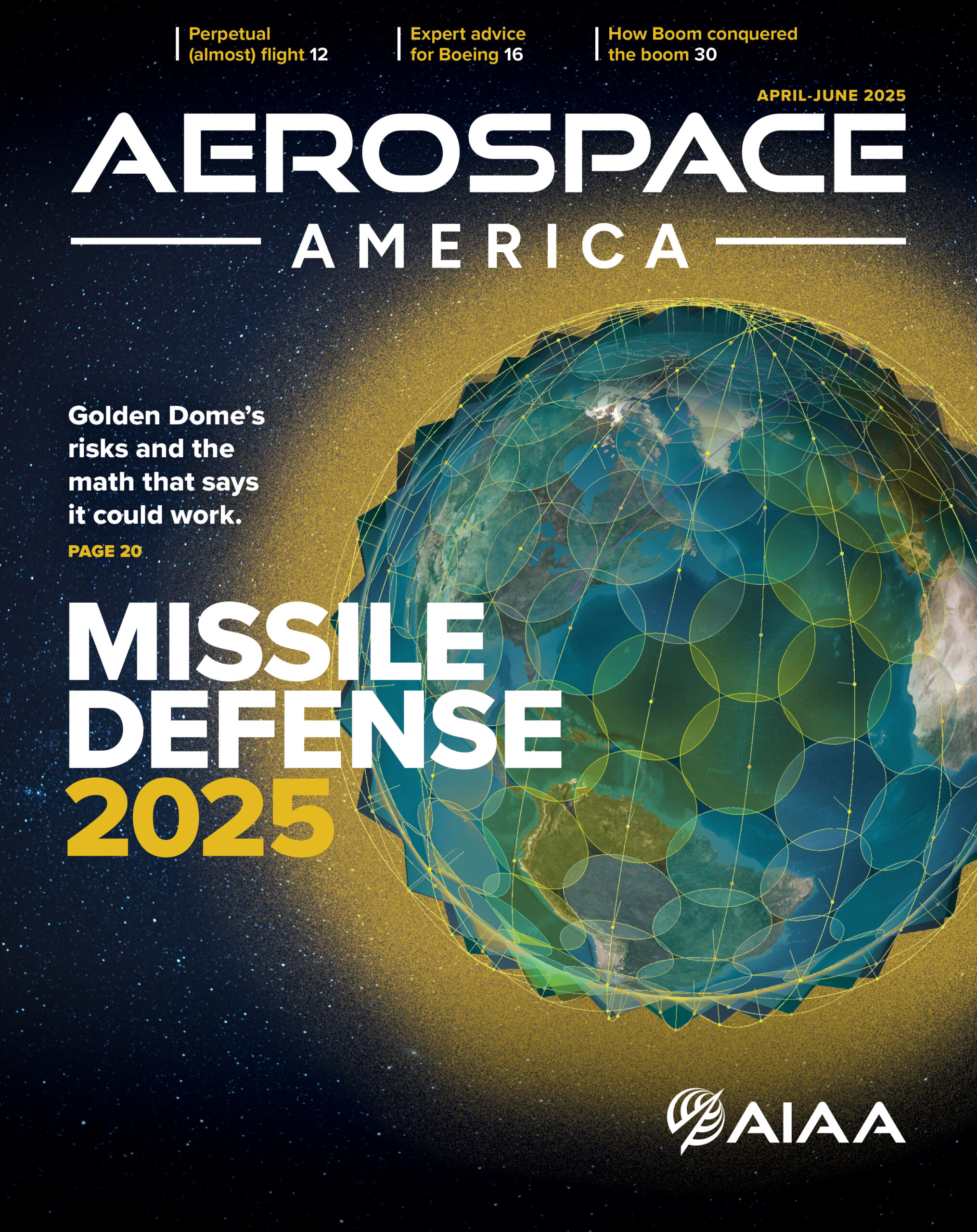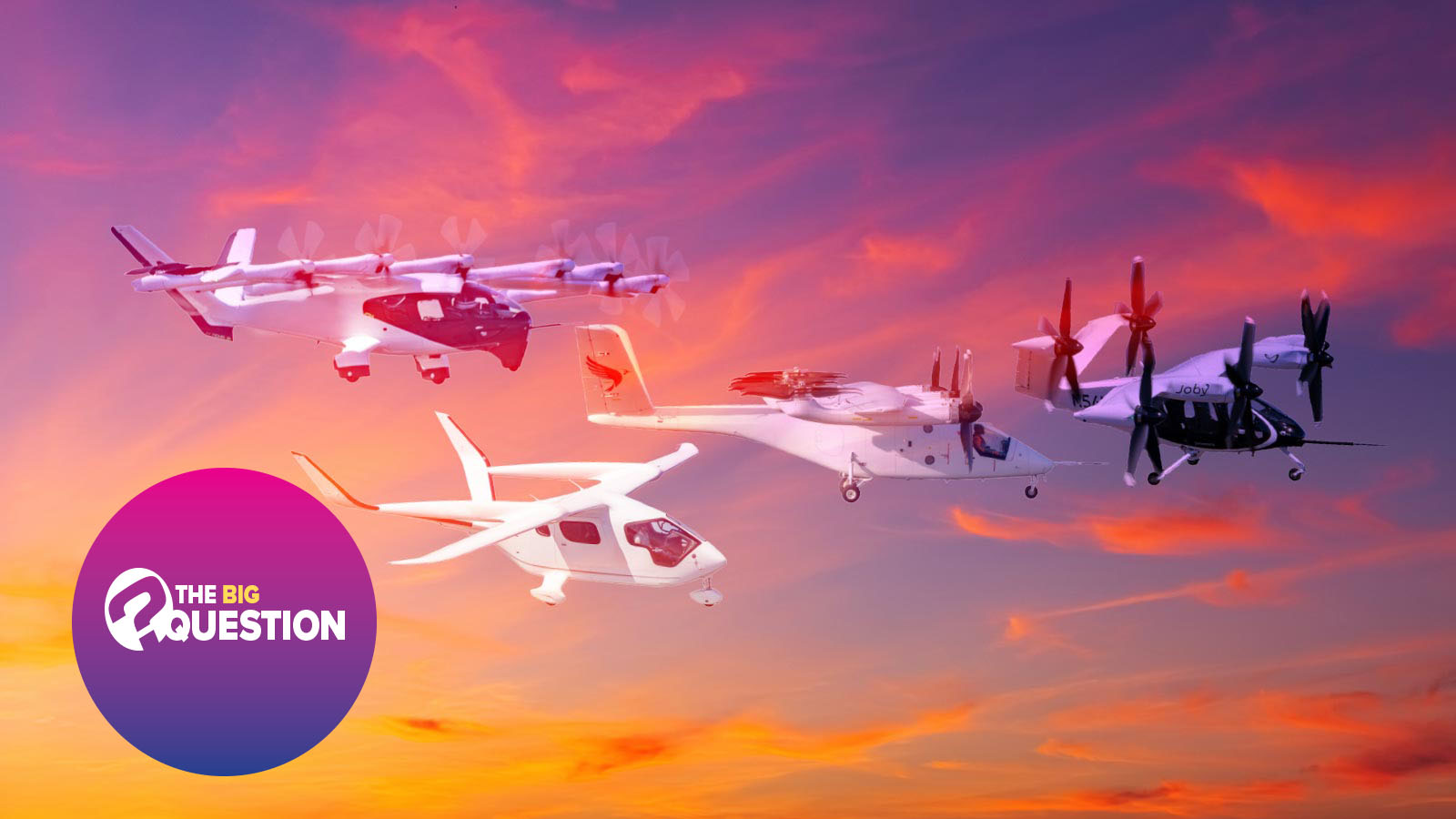Stay Up to Date
Submit your email address to receive the latest industry and Aerospace America news.
It’s been nearly 10 years since Uber announced its Elevate initiative for “on-demand urban air transportation,” in which anyone would be able to hail a small electric air taxi with the push of a button, much like ordering a car in the Uber app. In this grand vision, hundreds of battery-powered aircraft would soar through the skies, reducing road congestion and pollution and “giving people their time back.” Today, this concept of advanced air mobility has expanded to also encompass scheduled service, longer-distance trips and aircraft with hybrid-electric propulsion. That future has yet to arrive, though it may be getting closer: Chinese developer EHang in 2023 received regulatory approval for its single-seat aircraft, though passenger flights have not begun in earnest. In the U.S., California developers Archer and Joby Aviation are awaiting FAA type certificates for their four-seat designs but say they could begin passenger flights in the Middle East as soon as next year. Will we ever travel like the Jetsons? Six experts from government, industry and academia weighed in.

I think there is a great deal of promise in electric aviation technology, but it’s a technology that hasn’t found the right market yet. For short distances, electric aircraft are difficult to sell. People used to come to the Air Force all the time and say they can do a “short hop” flight. And the response was always, “We have Cessnas for that.” Today, there isn’t a single application for an eVTOL [electric vertical takeoff and landing aircraft] in any mission for the Air Force.
Part of that disconnect stems from the fact that people started with the technology and then tried to figure out what problems it could solve. But the problem and solution have to come first, and then you have to design for that. At the same time, some of that learning would never have taken place if we didn’t first develop the tech. For instance, we had to design battery-only aircraft to realize that hybrid-electric propulsion might be the most promising for the near term.
In my view, the sweet spot for advanced air mobility is actually suburban or regional transport — trips like from Santa Cruz to Berkeley, which are both outlying cities in the San Francisco area. But once you get to Berkeley, it’s congested, so where are you going to land? These are the problems to be solved still.
The other piece of this is to design for increased autonomy. This would relieve some of the training requirements for a pilot, and that shortens today’s years-long training process. For example, I spent a lot of time flying an F-16, and they are not simple. There’s buttons everywhere, and you spend a lot of time getting trained. But the first time I sat in an eVTOL, I was amazed at how simple it was. It was like the first time you saw an iPad when you were used to desktop computers. Based on that, I think a human can become competent at piloting an electric aircraft in something like three months.

I’ve never been one of these evangelist types that believe electric air taxis will change everything. We said from the very beginning, this is just one new tool in the transportation portfolio of a large city.
In the short term, every service, every product, when it comes out, it’s always more expensive than it could be. The final democratization of this transportation technology comes when you have very high frequencies, many flights, coupled with autonomy so that you don’t need a pilot on board. In the early days, when we have a few of these airplanes flying around and they all have pilots on board, it’s going to be more of a premium service. After that, you can make electric air taxis super cheap by subsidizing them with public money and investors.
If you remember back to the early days of Uber, the prices were probably half of what they are now because the company was trying to grow and conquer territory, funded by investors. Today, however, you’re now basically paying what it costs to take that Uber ride. So the whole idea that a flight on an electric aircraft will cost as much as driving a car is merely promotional. Let’s leave that in the early brochures of Uber Elevate. But I can see such flights becoming cheaper and more affordable, eventually comparable to an Uber Black premium ride. But there is a lot of work that needs to be done to get there, and you will need a high volume of passenger traffic.
Many new entrants, new companies, thought they could fix all of the inefficiencies in today’s ground transportation by bringing in the Silicon Valley mentality to innovate rapidly. They failed to understand that these are not computers that fly; these are airplanes and carry with them all of the safety requirements of being an airplane. Aircraft are not like software because there’s no beta version or early release. An airplane is either certified or not certified. There’s no in between.
The idea that any company in the U.S. or Europe will enter service in 2025 is just impossible. I’ve asked them about this and their latest answer is, “We’re working on it.” So rather than keep throwing out dates that are not going to work, now they’re saying, “Let’s just put our heads down and figure this out.” Even entering into service by 2026, or early 2027, is an optimistic view of when we’ll start seeing air taxis in the United States. And I believe that the first air taxi will be hybrid-electric. For now, hybrid propulsion has emerged as the only way to bring some of these benefits of electrification to market without negating the range needed for regional flights and military interest.

Electric aircraft would reduce maintenance schedules and costs and enable cleaner, quieter, and more sustainable flight operations. However, aircraft price range and stringent regulatory constraints are still obstacles.
An important aspect that must be considered is the timeline for electric air taxi services to be accessible to the public, or if they will remain a service for a tiny, wealthy niche. A small electric aircraft may cost less to build and operate (at least in the short term) than a traditional turbine-powered helicopter. However, whether an electric air taxi ride will ever be affordable enough for a middle-class urban family to choose over a metro trip or a rideshare car service remains unclear.
Think back to electric cars; for two decades, they were only accessible to the richer population. While investor dollars continued to fund advancements in this technology, the prices of these vehicles stayed out of the reach of most of the population. Only when production reached relatively high levels, making the cost more accessible, and when a robust intercity charging network arose, did electric cars begin to creep into the mainstream. Even now, prices remain notably above gasoline vehicles in many markets, and questions about longevity remain. For instance, a well-maintained gasoline car can live for decades, but a well-maintained EV car will likely need a new, costly battery replacement much sooner.
Electric air vehicles face all those same dynamics and more. Yes, the price of an air taxi might be drastically lower than a turbine- powered helicopter, but you are still looking at a price tag estimated at $300,000 to $1 million. Additionally, to enable sustainable electric flight, there is a need for battery-charging infrastructure, local approvals for takeoff and landing sites, and preapproved flight corridors.
Also, today’s air traffic system isn’t designed for thousands of five-seat electric air taxis buzzing around urban skies. Unless regulators fundamentally rethink airspace access, such operations will be limited to a few certified crews and some privileged passengers, just like turbine-powered helicopters are today. Also, with constrained landing pads and slow recharging cycles, fleet sizes will be small, flight frequency will be low, and per-seat costs will be high.
While electric aircraft may compete with turbine-powered helicopters for short-distance flights in remote or time-critical routes — think mountain resorts, island hops, urban executive commutes — without a revolutionary business model and regulatory overhaul, air taxis might remain a premium service for the foreseeable future.

I still think there is a good promise of changing mobility using the advancements in electric propulsion, increasing autonomy and with many smaller aircraft. What this does is expand the way aviation will reach different communities, in a nutshell. We are starting to see some movement already with small drones operating in limited areas, and I think that’s the beginning of real advanced air mobility.
We want to see advancement quickly. Everybody’s impatient and gets excited about it, but it takes time to mature, integrate and to show that it is safe. Jeff Bezos said in 2013 that Amazon would begin drone deliveries in five years. It’s taken longer, but I don’t think that a few years here and there matter so long as we are doing it right, and doing it in a way that will be sustainable and see steady growth. From the perspective of NASA, we are also focused on not just one or two aircraft flying, but how we make sure that the whole ecosystem survives and thrives. Aircraft and airspace and infrastructure — all those pieces have to come together.
I don’t have a lot of experience dealing with other countries, so I cannot speak for them. But here in the U.S., we have the right spirit, the right type of ecosystem and a regulatory environment that allows innovation to flourish. We also have one of the most complex air transportation systems. When anyone allows a new entrant in the airspace, they have to be very diligent about not impacting the overall safety of the current users, and that takes time. There is a national strategy that’s evolving, led by the U.S. Department of Transportation, and Congress is very interested in this topic. And there is already the Advanced Air Mobility Coordination and Leadership Act underway, which Congress passed in 2022.
In terms of adoption, it will likely be similar to what we saw in the development of the commercial passenger aviation sector. There was a time when only people wearing nice suits were flying, right? That’s no longer the case. Passenger aviation has really become something for everyone, and that’s the goal: to see how advanced air mobility can get there. If we do this right, there could be a paradigm shift 50 years from now in terms of where people can live, or offices can be located, where they can be reached by advanced mobility aircraft, without having to only be confined to places where the road takes you. The real promise of AAM is more distributed, integrated living spaces.
But first, we need to see aircraft certificated and then the manufacturing capacity increase. And then we will see growth in traffic and airspace coordination and local preparedness — electric charging stations and vertiports, that kind of infrastructure. It’s a matter of funding, policies, technology readiness, infrastructure and demonstrating that it’s all going to be safe. We don’t want to rush into something.

Advanced air mobility should be able to provide another form of transportation to enhance the way people are able to get in and around cities relative to the existing options — cars or trains — which are subject to congestion just because of the way our infrastructure is designed. There’s just no great solution to simplify existing infrastructure or to improve it much in a city like New York, where everything’s very old. There’s no great way to improve the rail infrastructure, for example, so the only solution is to fly over it, to go over terrain, over the water, over all the congestion.
Air taxis won’t ever be quite like Uber for the skies because the current FAA rules require that each aircraft has a pilot. So you’re limited by how many pilots you have for the near future, until autonomy advances. AAM will be less expensive than current businesses that shuttle people with helicopters. But it will be more expensive than a traditional Uber. The price should be somewhere between a standard Uber trip and a helicopter ride. So if that’s $80 and $200, an air taxi should be priced ideally around $150.
When it comes to urban air mobility — short trips in the cities — battery technology is already good enough. Most of these routes will be a maximum of 50 miles [80 kilometers] so that they have the required FAA battery reserve of 25 minutes in flight. And I think the leading companies are ready to scale up manufacturing to produce dozens of aircraft in the coming years. I saw Joby Aviation’s California facility in March, and they were building several aircraft simultaneously. I don’t think ramping up the manufacturing is the most significant hangup right now.
Most optimistic predictions for getting certified have been delayed, but I never expected anyone to get an FAA type certificate at the end of 2024. But progress is being made, and Joby at least expects to start FAA Type Inspection Authorization flight testing before the end of this year. That’s like a six- to nine-month process, and I expect it to be on the longer end of that. So that would be mid-2027 for a type certificate and then a manufacturing certificate soon after. And this would be the first completely new aircraft type to be certified by FAA in more than 80 years. The last major technological innovation in aviation would have been the start of the jet age in the 1960s.
We are seeing some companies aiming to begin service early in the Middle East and the United Arab Emirates, but I still think the regulators there will wait for FAA to issue a type certificate before allowing these aircraft to carry passengers other than their own employees. [California developers Archer and Joby have said they could begin ferrying passengers in the United Arab Emirates by early 2026. — PB] I’m also very skeptical that EHang or any other Chinese manufacturer will be able to get certified for passenger service outside of China anytime soon; EHang’s aircraft is carrying passengers without a pilot onboard.

The January accident near Reagan National Airport outside of Washington, D.C., soured me on the promise of AAM a little. If we can’t keep a helicopter and an aircraft on approach apart in a Class B airspace, how are we going to keep these aircraft apart when there are dozens or hundreds of them flying over cities?
The first hurdle in the critical path is achieving commercial certification. Urban air mobility is not going to happen in 10 years, or even 20 years, in terms of dense traffic by electric aircraft. Closing the business case will be a big challenge. Time-consuming training of electric air taxi pilots will affect the number of flights. Even with the fuel and maintenance savings from electric propulsion, the projected cost of a ride is not a lot different than a helicopter.
The first users will be tourists and the wealthy. To get to widespread “taxi” use, the relative cost needs to be cheaper; using automation, with a remote pilot or monitor, may be the only way to achieve that. But years of flawless safe unpiloted experience are needed to prove unpiloted air taxis to the public.
The U.S. lacks low-altitude flight rules, beyond corridors. There are no defined flight levels below 3,000 feet. Precise altitude estimation and sharing will be necessary. Currently, small aircraft altitude is estimated with destination or origin pressure altitude, GPS, radar altitude or cellphones. Whatever technology we choose to use, reportable altitude needs to be at a better standard level of accuracy. Noncooperative detect-and-avoid sensing is necessary but not sufficient to enable safe density in low altitudes. Industry experts are working to write and promulgate standards in all these areas, working with FAA for approval and implementation.
We are seeing leading U.S. companies announce they will begin operations in the Middle East, which indicates a failure in the U.S. to support introduction of new vehicles. [She’s referring to plans by Archer and Joby to begin passenger service in the United Arab Emirates before the U.S. — PB] China is very supportive of AAM business, but the U.S. is much less so. That attitudinal difference is costing U.S. manufacturers as they go to market, so it’s taking much longer.
Meanwhile, China has surged ahead. The EHang 216 unpiloted aircraft achieved a type certificate from the Civil Aviation Administration of China, but is still awaiting first commercial passenger flights. EHang announced approval of essentially tourist flights, taking off and landing at the same spot, in Wuhan or Shanghai. Hopefully China’s regulators value safety as much as the U.S. If not, as the Chinese AAM companies build operational hours, there will be incidents and there will be a backlash against that. From here, it is impossible to tell whether safety in China is being compromised as they move faster than the rest of the world.
About paul brinkmann
Paul covers advanced air mobility, space launches and more for our website and the quarterly magazine. Paul joined us in 2022 and is based near Kennedy Space Center in Florida. He previously covered aerospace for United Press International and the Orlando Sentinel.
Related Posts
Stay Up to Date
Submit your email address to receive the latest industry and Aerospace America news.




